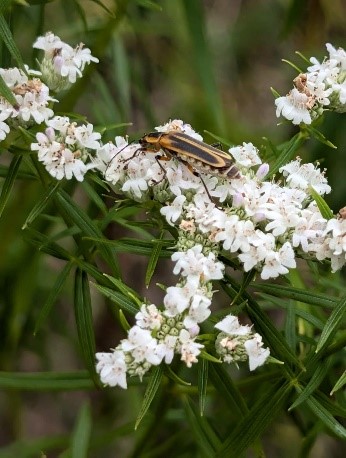Last updated: July 18, 2024
Lesson Plan
Exploring Habitats at Abraham Lincoln Birthplace National Historical Park

There are many places for insects to live!
National Park Service
- Grade Level:
- Lower Elementary: Pre-Kindergarten through Second Grade
- Subject:
- Science
- Lesson Duration:
- 60 Minutes
- State Standards:
- Kentucky:
2-LS4-1. Make observations of plants and animals to compare the diversity of life in different habitats. - Thinking Skills:
- Remembering: Recalling or recognizing information ideas, and principles. Understanding: Understand the main idea of material heard, viewed, or read. Interpret or summarize the ideas in own words. Applying: Apply an abstract idea in a concrete situation to solve a problem or relate it to a prior experience. Analyzing: Break down a concept or idea into parts and show the relationships among the parts. Creating: Bring together parts (elements, compounds) of knowledge to form a whole and build relationships for NEW situations. Evaluating: Make informed judgements about the value of ideas or materials. Use standards and criteria to support opinions and views.
Essential Question
What types of animals live in the habitats at park?
Objective
Students will make observations of plants and animals in different habitats within the Abraham Lincoln Birthplace National Historical Park to compare the diversity of life.
Background
The teacher needs a thorough understanding of habitats, biodiversity concepts, and the specific ecological features of the park. They should be familiar with different types of habitats (e.g., forest, grassland, wetland) and the plants and animals typically found in each. Knowledge of how to facilitate outdoor learning experiences, including guiding students in making detailed observations and documenting their findings, is crucial.
Preparation
- Pictures or illustrations of common plants and animals (native to the park.)
- Notebooks or observation sheets for each student
- Pencils or crayons for sketching
- Clipboards (optional, for outdoor observations)
- Magnifying glasses (optional, for closer observations)
Materials
Lesson Photos: https://www.nps.gov/media/photo/gallery.htm?id=76932B64-1BF0-4F97-B7F1-651F4EE694FD
Download Photos for Lesson Plan
Students will be able to use this template to make plant and animal observations. They can draw pictures or write detailed observations. Teachers also have the option to just have the students use a notebook or piece of paper for their observations.
Download Observation Graphic Organizer
Lesson Hook/Preview
Students will be introduced to habitats.
Procedure
Step One: Introduce Habitats:
- Discuss what habitats are and give examples (forest, grassland, wetland, etc.).
- Explain that different plants and animals live in different habitats because they provide the resources they need to survive.
- Show pictures or videos of the park, including the landscape and different habitats found there.
- Discuss briefly why the park is named after Abraham Lincoln and its historical significance. (This is the birthplace of the 16th president. - Born in a one-room log cabin on his father's Sinking Spring Farm on Sunday, February 12, 1809, Abraham Lincoln's early years on the Kentucky frontier helped to shape his character and prepare the boy who would grow up to become the 16th President of the United States to lead the nation through the tragic and turbulent times of the Civil War. His legacy of liberty and equality remains relevant today and continues to impact people around the world)
- Explain that biodiversity refers to the variety of plants and animals living in a particular area.
- Emphasize that by observing and documenting plants and animals, we can learn about the diversity of life in different habitats.
- Practice observation skills in the classroom or other outside area at school by identifying and sketching common plants and animals.
- Discuss how to make detailed observations and record them in their notebooks or a blank sheet of paper.
Vocabulary
Biodiversity: the variety of plants and animals living in a particular area.
Habitat: the place where living things naturally live and grow. Habitats provide them with the food, water and shelter they need to live
Supports for Struggling Learners
- Struggling students may be allowed to draw their observations instead of writing down their detailed observations if necessary. \
- Provide magnifying glasses or other assisting tools for students who may benefit from closer observation of details in plants and animals.
- Encourage small group work where students can discuss ideas, ask questions, and learn from each other's perspectives.
Enrichment Activities
- Encourage them to use more scientific terminology in their observations and descriptions.
- They could investigate a specific plant or animal species in depth, exploring its lifecycle, adaptations, ecological role, and conservation status.
Related Lessons or Education Materials
This lesson was created by Kentucky teachers as a part of the History and Science Explore Project.
